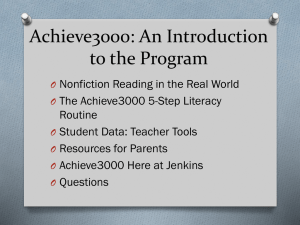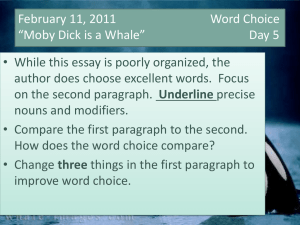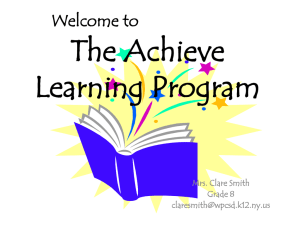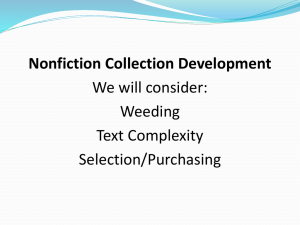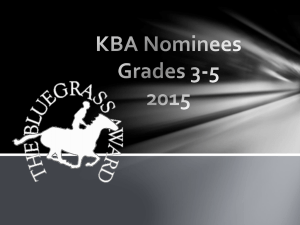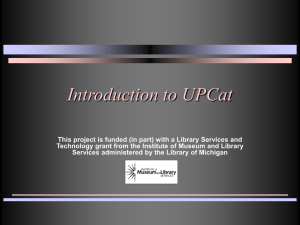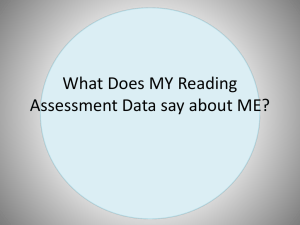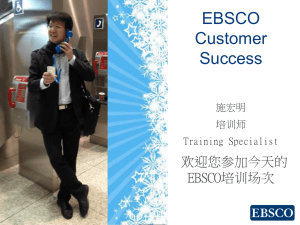Session Four - Achieve3000
advertisement
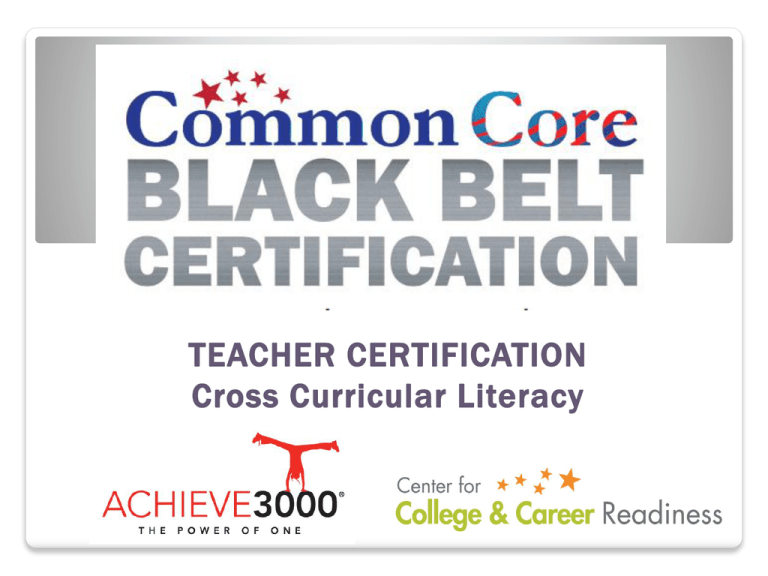
TEACHER CERTIFICATION Cross Curricular Literacy NATIONAL PATHWAY FOR COMMON CORE IMPLEMENTATION SESSION FOUR PAIRING NON-FICTION Slide 2 www. CollegeCareer .Org WELCOME Your Faculty Kevin Baird Chairman, Center for College & Career Readiness Slide 3 TODAY’S SESSION PAIRING NON-FICTION Materials You Need: .wmv Video File .pdf Power Points .pdf or .doc Slide 4 Session Four Session Four Practice & Synthesis Four ACHIEVE3000 Log-In TODAY’S OVERVIEW Review: Home Work Pairing Non-Fiction Strategy Close Reading Outline Slide 5 HOME WORK! Home Work Activity Goal: Working with Lexiles® Activity: Identify How to get Lexile® Data in School Use Lexile.com to Determine Lexile® Level *Use ACHIEVE3000 Lexile® Data Slide 6 PAIRING NON-FICTION INFORMATIONAL TEXT Slide 7 THE NATIONAL PATHWAY A Process of Discovery, Support and Mastery Slide 8 THE ALIGNMENT PROCESS Establish Goals Measure to Focus on Priorities Align Practice to Goals & Priorities Curriculum Instruction Assessment Observe, Communicate, Teach, Direct Slide 9 Refinement Conditions for Successful Implementation Curriculum Mapping Implementation Vision + Skills + Incentives + Resources + Action Plan Plan = Sustainable Change Skills + Incentives + Resources + Action Plan Plan = Confusion Incentives + Resources + Action Plan Plan = Anxiety Resources + PlanPlan Action = Resistance PlanPlan Action = Frustration = Treadmill Vision + Vision + Skills + Vision + Skills + Incentives + Vision + Skills + Incentives + Resources Key Questions: the direction to Vision: The “Why are we doing this?”Resources to combat confusion. -- "Do we have tools,Plan: time,Provides and training to map effectively?" Vision -- "Why are we doing this?" eliminate the treadmill effect. Skills: The skill sets needed to combat anxiety. Skills -- "How do we build effective maps?" Action Plan -- "Over the next three years, do we have attainable Incentives:-- "How Reasons, perks, advantages to combatand resistance timelines goals? Who will be the responsible parties for Incentives will mapping improve implementations, monitoring, and feedback?" Resources: Tools and time needed to combat frustration. teaching and learning?" Knoster, T., Villa, R., & Thousand, J. (2000) COMMON CORE STANDARDS FOR ENGLISH LANGUAGE ARTS AND LITERACY IN HISTORY/SOCIAL STUDIES & SCIENCE APPENDIX A: FINDINGS Students who fall short of ACT's college readiness benchmarks have the greatest difficulty with the test items involving the most complex text. K-12 reading assignments have become much less demanding in the last halfcentury, with an especially large drop-off in high school expectations. Weston, S. P. (2010). “The giant text complexity challenge inside the new literacy standards.” The Prichard Committee for Academic Excellence Slide 11 Today’s text gap Source: Metametrics Slide 12 Lexile® levels today and with Common Core – Rigor Increased 2-3 Grade Levels Slide 13 Current Common Core Typical text measures (by grade) Text complexity grade bands and associated Lexile ranges Percentage distribution of literary and informational passages – Non Fiction is Key Source: National Assessment Governing Board. Reading Framework for the 2009 National Assessment of Educational Progress. Washington, D.C.: American Institutes for Research, 2007. Slide 14 HOW? The Critical FIRST Step For Increasing Non-Fiction Is to PAIR Non-Fiction Informational Text With Existing Curriculum Slide 15 WHY? Math: Increase Text-based Problems Social Studies: Increase Lexile® Range Science: Increase Domain Vocabulary & Decrease Level of Struggle Literature: Increase Lexile® and Non-Fiction Slide 16 MATH Increase Text-based Problems Slide 17 STANDARDS FOR MATHEMATICAL PRACTICE IN A CLASSROOM McDonald’s Claim Wikipedia reports that 8% of all Americans eat at McDonalds every day. In the US, there are approximately 310 million Americans and 12,800 McDonalds. The average McDonald’s store can serve 1,500 people a day. In your own words, rephrase the math problem. What are you trying to figure out? (Briar s, Feb 2011) Slide 18 STANDARDS FOR MATHEMATICAL PRACTICE IN A CLASSROOM McDonald’s Claim Wikipedia reports that 8% of all Americans eat at McDonalds every day. In the US, there are approximately 310 million Americans and 12,800 McDonalds. The average McDonald’s store can serve 1,500 people a day. Rewrite the problem into an equation. (Briar s, Feb 2011) Slide 19 STANDARDS FOR MATHEMATICAL PRACTICE IN A CLASSROOM McDonald’s Claim Wikipedia reports that 8% of all Americans eat at McDonalds every day. In the US, there are approximately 310 million Americans and 12,800 McDonalds. The average McDonald’s store can serve 1,500 people a day. Do you believe the Wikipedia report to be true? Using mathematical evidence, defend your position. Is your position a fact, an opinion, or an estimation? ( B r i a r s , Fe b 2 01 1 ) Slide 20 THOUGHT VS. OPERATION College & Career Ready students Understand the argument presented Can analyze the structure of the argument Can solve for the problem in the language of mathematics, and defend their solution Our Traditional Approach - Computation Slide 21 WHAT DID YOU WRITE? Question: Is it possible for 8% of Americans to eat at McDonald’s every day, given the number and capacity of McDonald’s restaurants? Can 12,800 restaurants serving 1,500 people a day serve at least 8% of 310 Million Americans? Is 12,800 x 1,500 < = > 8% x 310,000,000 Slide 22 SOCIAL STUDIES Increase Lexile® Level Slide 23 PREPARING OUR STUDENTS FOR COLLEGE & CAREER Slide 24 SCIENCE Increase Vocabulary Decrease Level of Struggle Slide 25 TEXT COMPLEXIT Y Qualitative evaluation of the text Levels of meaning, structure, language conventionality and clarity, and knowledge demands Quantitative evaluation of the text Readability measures and other scores of text complexity Matching reader to text and task Reader variables (such as motivation, knowledge, and experiences) and task variables (such as purpose and the complexity generated by the task assigned and the questions posed) Slide 26 SCIENCE: MIDDLE SCHOOL Slide 27 ACT: The Forgotten Middle ACT: On Course for Success LITERATURE Increase Lexile® Level Increase Non-Fiction Percentage Slide 29 Slide 30 CLOSE READING First Two Words of the College & Career Readiness Anchor Standards for Reading: “READ CLOSELY” Example: David Coleman’s Gettysburg Address Lesson Three Paragraphs Three Days Read & Re-read 10-15 Times Slide 31 Slide 32 ROUTINE Slide 33 Study Vocabulary (Scaffold) Read Cold Paraphrase or Summarize (Write, Share) Read Aloud Text Dependent Questions Vocabulary Study Essay Write Central ideas/theme Create product Argument/ evidence Vocabulary HOME WORK! Home Work Activity Goal: Pairing Non-Fiction Text QUESTIONS? EMAIL Blackbelt@Achieve3000.com Slide 39 SCOPE & SEQUENCE ORIENTATION + 10 SESSIONS SUBMIT YOUR ANSWERS Within the next week, please submit your answers & any questions to: Blackbelt@Achieve3000.com Slide 41 GREAT JOB! TEACHER CERTIFICATION Cross Curricular Literacy Great Work! Slide 43 THANK YOU! Your Faculty Kevin Baird Slide 44 BlackBelt@Achieve3000.com
